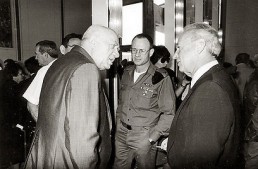Felix Beatus
 Felix Beatus was born in 1917 into an assimilated family in Kalisz. Around 1931, they moved to Częstochowa, where his family ran a paper-bag manufacturing business on ul.Garibaldiego. When War broke out in 1939, with his wife Francesca, he fled with the Polish army retreating into Russia-Ukraine, where he found work near the city of Sitri as a driver. Francesca worked as a nurse.
Felix Beatus was born in 1917 into an assimilated family in Kalisz. Around 1931, they moved to Częstochowa, where his family ran a paper-bag manufacturing business on ul.Garibaldiego. When War broke out in 1939, with his wife Francesca, he fled with the Polish army retreating into Russia-Ukraine, where he found work near the city of Sitri as a driver. Francesca worked as a nurse.
In June 1941, when Germany invaded Russia, Felix’s truck was stopped at a road block. That same night, he was drafted into the Red Army as a truck driver. Felix said to the Russian commander, “Either I’ll be a good soldier or no soldier at all. But you have to let me inform my wife that I’ve been drafted”. The Commander agreed and sent him, with a guard, to tell his wife. The next time he saw his wife was nearly four years later, after the War.
As a driver, Felix’s technical talent was already evident. There were no spare parts but many scrap vehicles were littered along the roads. At the age of 28, he was sent to the Ukrainian front, where he was wounded. When he recovered, he was sent to become a tank soldier in the Polish Army which had been established by the Soviets.
His commanders wanted Felix to become a Politruk (a army political officer), but he refused saying that he did not wish to become a “Politruk Jew among Polish soldiers”. However, his commanders insisted and threw him into prison, Eventually he was released and dispatched to a T-34 tank commanders course.
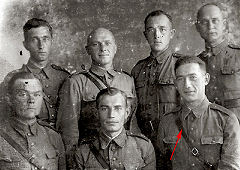
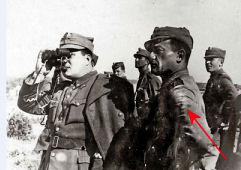
At the end of the course, in October 1943, Felix was sent to the fight near Warsaw with General Herling. The Poles sent him to an armoured officer’s course in Russia and then on to an advanced armoured reconnaissance course.
In July 1944, Felix’s Polish brigade arrived in Lublin and he was among those who liberated the Majdanek death camp. After Lublin, the great battle to retake Warsaw from the Germans began. Felix was in the intelligence unit’s patrol division which formed the bridgehead on the Wisła River, enabling the first tanks to cross to the other side.
The Warsaw Uprising broke out. The Polish military commanders wanted to join the rebels and to participate in the liberation of Warsaw, but the Russians were apparently more interested in the downfall of the Polish Army. The Uprising failed with thousands of casualties.
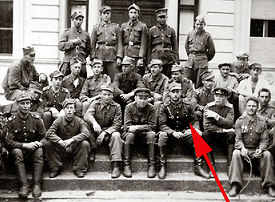 Meanwhile, Felix’s commanders decided to send him to the Molotov Academy in Leningrad where, for half a year, he studied advanced armoured warfare. This was vocational training at the highest-level given to commanders of armoured brigades. Study was based on lessons learned from fighting the war, not yet ended. Each participant learned combat planning and practice of a full armoured brigade. Field training sessions were held at brigade level with the help of Finland.
Meanwhile, Felix’s commanders decided to send him to the Molotov Academy in Leningrad where, for half a year, he studied advanced armoured warfare. This was vocational training at the highest-level given to commanders of armoured brigades. Study was based on lessons learned from fighting the war, not yet ended. Each participant learned combat planning and practice of a full armoured brigade. Field training sessions were held at brigade level with the help of Finland.
Following this training, Felix returned to the Wisła front where he commanded a Polish Army armoured battalion comprised of Russian soldiers and tanks. In one of the fiercest battles against the Germans, in April 1945, his force was practically destroyed, leaving him with only seven tanks. Russian reinforcements of Stalin tanks with 122mm guns saved the rest of his unit. In May 1945, he completed his service on the border of the Czech Republic and Germany.
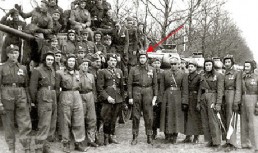
Felix was then called, with his unit, to the city of Stettin, where Germans, Russians and Poles, who returned from captivity, were fighting each other. He received an order from Moscow to clear the city of German residents, and turn it into purely Polish town before the Potsdam Conference (July 1945, the division of spheres of influence in Europe following the fall of Germany). Stettin then became Szczecin.
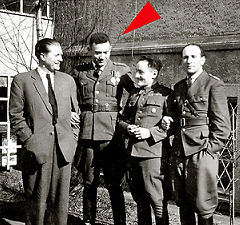
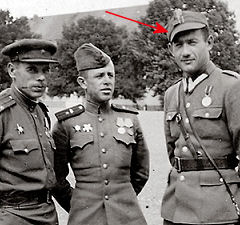
Within six weeks, Felix had managed to transfer a quarter of a million German inhabitants of Stettin and had become Military Governor of the city. It was here that Felix was first exposed to “Irgun Ha’Bricha”. Under pressure from his wife, he met with members of the Aliyah Bet organisation and helped them to illegally smuggle Holocaust survivors to Palestine.
On 16 April 1946 the Polish Government decided to hold a victory parade in Szczecin and Felix was assigned the task of organising it. Among the guests he invited was a Jewish youth group undergoing agricultural training prior to immigration to Palestine. While heading the parade’s armoured column, he could see Jewish youth marching with both the Polish flag and the blue and white flag. He also saw how they were despised by thousands of the Polish Scouts yelling “Jews to Palestine”. It was apparently then that he came to the decision to immigrate to Israel.
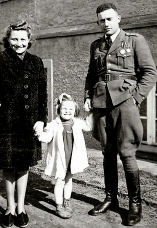 On 27th May 1947, Felix arrived in Palestine with his family. While he was fluent in Polish, Russian and German, he knew not one word of Hebrew. Maccabi Motzri (a senior Haganah and Palmach officer at the time) met him and took him to meet with Yitzhak Sadeh, Yigal Allon and Dan Lehner in a Tel Aviv Cafe. With Yitzhak Sadeh, he spoke Russian, with Dan Lehner, he spoke German. However, Yigal tried to speak to him in Yiddish, a language which Felix did not understand. “How come you are Jewish and don’t understand Yiddish?”, Allon asked him.
On 27th May 1947, Felix arrived in Palestine with his family. While he was fluent in Polish, Russian and German, he knew not one word of Hebrew. Maccabi Motzri (a senior Haganah and Palmach officer at the time) met him and took him to meet with Yitzhak Sadeh, Yigal Allon and Dan Lehner in a Tel Aviv Cafe. With Yitzhak Sadeh, he spoke Russian, with Dan Lehner, he spoke German. However, Yigal tried to speak to him in Yiddish, a language which Felix did not understand. “How come you are Jewish and don’t understand Yiddish?”, Allon asked him.
With an interpreter, Felix was sent first to the Galilee, where Yitzhak Sadeh had asked him to organise the planning of its defence. In Kibbutz Ayelet Hashachar, he met Molah Cohen, commander of the Palmach Third Battalion, who asked him “How long have you been in the country? You seem so familiar with the area!” According to Dan Lehner, “Felix has been here only a few days and knows all the places just from studying the maps”.
Until March 1948, Felix was busy creating an armoured warfare training facility. He had brought with him a great deal of training literature and translated it in the Sarona training camp (now the Ministry of Defence centre in Tel Aviv).
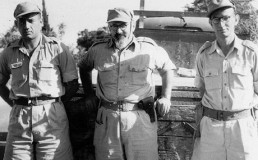
When the fighting began on the roads, he persuaded Yitzhak Sadeh to stop using armoured “sandwich” vehicles with arrow slits, since they were like death traps with limited fire and observation possibilities. Instead, he developed a protected vehicle based on a Dodge truck with a welded steel bottom plate and top turret of steel with the possibility of easy swing and machine gun openings.
Yitzhak Sadeh then called Felix and said to him, “We have some tanks!”
According to Felix, “We came to a large warehouse at the port of Tel Aviv. There were ten Hotchkiss H-35 tanks, each one with a technical problem. This was a French tank, developed after World War I, with a short 37mm cannon. The next day we went to an orchard in Bnei Brak where there were some half-tracks.
“That’s it”, said Yitzhak Sadeh. “Now we can form an armoured battalion.”
“That’s not enough”, replied Felix. “We still need soldiers, mechanics, communications, ammunition and supplies”.
“Look”, said Yitzhak Sadeh. “We have a Commander, that’s you, and we have tanks. As far as the rest is concerned, we’ll manage!”
Felix recalled that “during the first two weeks of April, new immigrants, who previously served in the armoured corps, started arriving from Czechoslovakia and Russia. They began to get organized in Tel-Levinsky, amidst a jumble of languages. I decided to set up three companies: the Slavs would have the Hotchkiss, the Anglo-Saxons would have the Cromwell tanks stolen from the English and the two Sherman tanks assembled from different spare parts, and an Etzel squadron under the command of the Jacob Banai would get the half-tracks”.
With the 8th Brigade, commanded by Yitzhak Sadeh, the first armoured battalion of the IDF (the 82nd) under the command of Felix Beatus, was established in May 1948 and it’s first battle was in Operation Dani, the conquest of Ramle-Lod, the nearby airport and the villages and roads in the area.
